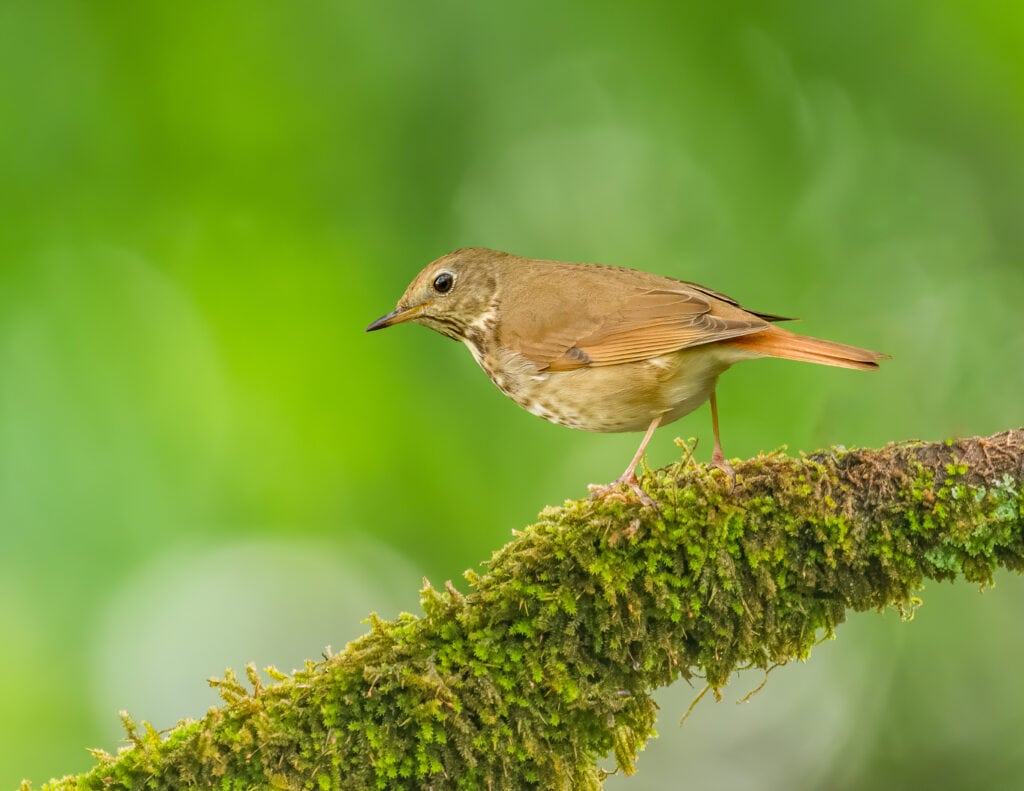The Hermit Thrush is a personal favorite of mine, and if its understated but beautiful speckled brown plumage isn’t enough to tell you why, just wait until you hear one sing! The Hermit Thrush is known for its breath-taking flute-like song. This song is often described as nature’s most beautiful sound. This is high praise indeed, but the crystal clear ethereal notes of the Hermit Thrush’s song deserves every bit of it.
Early 19th century naturalist F. Schuyler Mathews described the song of the Hermit Thrush in his book, A Field Book of Wild Birds and Their Music:
“Now the Hermit Thrush is an altogether different kind of a singer, as the ensuing notations will show. He is brilliant in execution beyond description, as versatile in melody as a genius, and as pure in his tones as refined silver. It would be useless to attempt a representation of the song by a series of dots and dashes; the mechanical rhythm is completely overshadowed by the wonderful way in which the singer delivers his sustained tonic and then embroiders it with a rapid and brilliant cadenza.”
With a name like the “Hermit Thrush,” you might think that this bird is hard to find. And despite being a fairly common songbird, these relatives of bluebirds and robins are shy and often hard to spot. They also closely resemble a few related songbirds, so it can be difficult for inexperienced birders to tell them from their doppelgangers. Still, even when you can’t see a Hermit Thrush, that song is unmistakable and often used to identify them.
Related Article: Excitement and Tragedy as Chicago Migratory Bird Fallout Event Turns Fatal
Fun Facts About the Hermit Thrush
Though they may look unassuming, the Hermit Thrush is a bird that sticks with you. Its exceptional musical ability carries the beauty of nature itself in every note. Let’s take a look at some Hermit Thrush fun facts to learn more about this gorgeous bird.
Territorial troubadour: I’ve already discussed the beauty of the Hermit Thrush’s famous song, but its purpose is also interesting. Although it might sound lovely, male Hermit Thrushes sing to defend their nesting territory. It’s a declaration to other Hermit Thrushes that says: “I am here. This is my spot. You’d better keep moving!” But territorial singing isn’t the only vocalization that Hermit Thrushes make. They also have calls for greeting each other in the nest, tending their eggs, and even one call that is said to sound like a mewing kitten.
It’s free real estate: Hermit Thrushes normally nest in trees or bushes, but they occasionally make more interesting choices when it comes to real estate. They have been found with nests built atop cemetery graves, on golf courses, and inside of mine shafts.
Suppertime tap-dance: Hermit Thrush’s have an interesting foraging method that might be confusing to a birdwatcher that hasn’t seen it before. Standing on the ground, a Hermit Thrush will shake or “quiver” its feet. This motion startles insects into action, causing them to move and revealing their location to the waiting bird that then snatches them up. Hermit Thrushes are far from the only birds to do this, but it is nevertheless a strange sight to witness.
Vermont’s favorite: The Hermit Thrush is the state bird of Vermont. It was recommended by the Federated Women’s Club and officially chosen to represent the state in 1941.
The Future of the Hermit Thrush
As of its most recent assessment in 2020, the IUCN Red List of Threatened Species has determined the Hermit Thrush to be of “Least Concern” with stable populations throughout its vast range. Despite the delicate sound of its song, the Hermit Thrush is a relatvely hardy and adaptable bird.
Popular Article: Species Spotlight: The Killdeer

